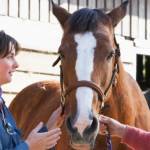Australian Equine Disease Alphabet

Equine diseases, conditions, or problems are frequently referred to by their initials. Full names, a brief explanation of each condition, and management tips, if applicable, are given below.
ASH-Australian stringhalt. Characterized by abnormal and sometimes violent movement of hind limbs when the horse is walking or trotting. Caused by grazing on drought-stressed pastures in Australia and New Zealand. Phenytoin, baclofen, and vitamins B and E have been used to reduce signs of the condition, and results have varied. Normal motion can take up to 18 months to be restored.
CEM-contagious equine metritis. Inflammation of the female reproductive tract. Highly contagious. Mare shows discharge after breeding, fails to conceive. No signs in stallion.
COPD-chronic obstructive pulmonary disease (heaves). An allergic reaction to inhaled dust and mold spores in hay and bedding. Affected horses are exercise-intolerant. Control by wetting hay before
DOD-developmental orthopedic disease. Any one of several conditions characterized by abnormal maturation of cartilage or bone. Some DOD can be prevented by proper nutrition of broodmares and encouraging steady moderate growth rates in young horses.
EGUS-equine gastric ulcer syndrome. Common in box-kept horses such as those in training. Horses go off feed, may not want to work. Turning horses out on pasture is the most natural cure.
EHV-equine herpesvirus. Different types cause a range of signs including respiratory disease, neurologic deficits, and fetal loss.
EI-equine Influenza. Acute, highly contagious viral disease that can cause rapid-spreading outbreaks of respiratory illness. An outbreak occurred in Australia in 2007 and caused a major impact on the country’s multibillion dollar horse racing and recreational industry. Australia is one of the few countries that has been successful in eradicating equine influenza.
EIPH-exercise-induced pulmonary hemorrhage. In affected horses, strenuous exercise causes breakage of small blood vessels in the lungs. Some “bleeders” show a trickle of fresh blood from one or both nostrils after exercise. Precise cause has not been determined. Treatment with furosemide is often helpful.
EMND-equine motor neuron disease. Symmetrical paralysis, muscle atrophy, and weight loss are early signs of this fatal disease that is linked to high copper and low vitamin E concentrations in the spinal cord. Similar to Lou Gehrig’s disease in humans.
EPM-equine protozoal myeloencephalitis. Signs are stumbling, incoordination, asymmetrical muscle wasting. Caused by Sarcocystis neurona protozoa in the central nervous system.
ES-equine strangles. The most important infectious disease caused by the bacterium Streptococcus equi. Highly contagious and spread by discharge from nostrils or pus from burst abscesses that form around the jaw and lymph nodes. Other symptoms include depression, fever, and inappetence. Isolation of affected horses is essential to prevent spreading. A vaccine is available and should be given every six months in high-risk horses. These include any horses required to travel regularly for performance or breeding purposes.
EVA-equine viral arteritis. Contagious disease that causes fever, respiratory disease, swelling of the face and legs, and abortion.
HV-Hendra virus. Highly contagious virus unique to Australia and deadly to horses and people. Carried by fruit bats that are unaffected by the disease, and spread to horses through the bat’s saliva. Usually characterized by an acute onset of fever and rapid progression to death, though a range of symptoms including neurological signs and respiratory failure have also been seen. Since 1994 there have been 46 horse and 4 human deaths directly related to Hendra, and strict biosecurity regulations are in place to prevent further spread of the disease.
HYPP-hyperkalemic periodic paralysis. Genetic disease of stock-type horses. Affected horses may show loss of coordination, muscle spasms, collapse, or death. Limiting intake of potassium helps some horses lead more normal lives.
NSH-nutritional secondary hyperparathyroidism (big head disease). Caused by grazing on tropical pastures that contain high levels of oxalates, which bind to calcium and prevent absorption, resulting in calcium being resorbed from bone and used to form weak bony deposits on the jaw and bridge of the nose. Can also be caused by diets high in phosphorus.
OCD-osteochondritis dissecans. A type of developmental orthopedic disease in which cartilage does not mature properly, causing various degrees of lameness in young horses.
OLWS-overo lethal white syndrome. Genetic disease of overo-patterned Paint horses. A foal inheriting the defect from both parents will colic and die within a few hours of birth. A DNA test can determine if breeding horses carry the mutation.
PCP-Paterson’s curse poisoning. Paterson’s curse is a toxic plant found throughout Australia. Toxicity mainly affects the liver, although kidneys and lungs may also be affected. Symptoms include loss of condition, anorexia, lethargy and dullness.
PRS-perennial ryegrass staggers. Caused by an endophyte in the leaves of perennial rye grass. Seen by a stiff gait and loss of control of movement. More prevalent in summer and autumn.
PSSM-polysaccharide storage myopathy. A form of tying-up often seen in draft horses. Primary signs are severe stiffness and muscle cramping.
RER-recurrent equine rhabdomyolysis. A form of tying-up. Primary signs are severe stiffness, muscle cramping, and reluctance to move.
RRV-Ross River virus. An arbovirus carried and spread by mosquitoes, not spread between horses. Symptoms include stiffness and soreness, muscle and joint pain with possible swelling, coughing, temperature, lethargy and nervousness.
SCID-severe combined immunodeficiency. Genetic disease of Arabian horses. A foal receiving the defective gene from both parents dies within a few months of birth from massive respiratory infection.
SDF-synchronous diaphragmatic flutter (thumps). Condition seen in endurance horses that are severely dehydrated and depleted of electrolytes, especially calcium. Electrolyte imbalance makes the diaphragm contract each time the heart beats. Treated by administration of electrolytes and fluids.
WLD-white line disease. Fungal and/or bacterial infection of the inner layers of the hoof wall. Damage to hoof layers and tissues can lead to lameness.
See the U.S. edition: Equine Diseases: Alphabet Soup Simplified.








